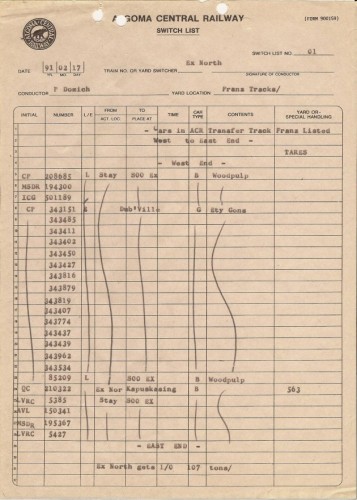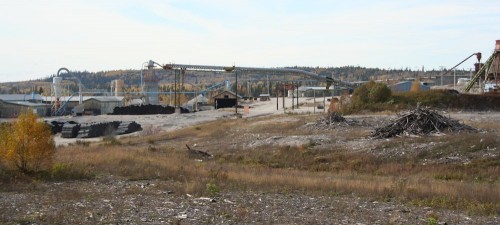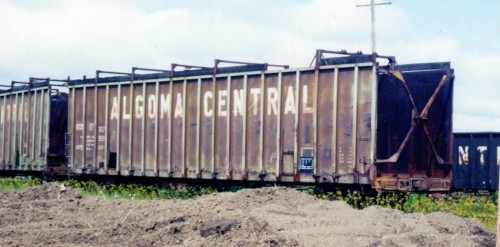Dubreuilville, located 20 miles north of Hawk Junction at milepost 184.2 on the Algoma Central’s Northern Subdivision, was the site of a sawmill operated by the Dubreuil Brothers Lumber Company (later Dubreuil Forest Products). The community of Dubreuilville was originally established as a company town in 1961 and incorporated as a municipality in the late 1970s.
Interestingly, despite the presence of the sawmill and related community, I don’t actually have information that a passenger station structure ever existed at this location. Today, passengers riding the regular passenger train that wish to travel to Dubreuilville are detrained at a nearby grade crossing a few miles south of town. The community of Dubreuilville is one of the stakeholders currently supporting efforts to save the regular passenger service, and apparently are also interested in having an official stop and shelter established if the service is able to continue under the new operator.
There was also never a full passing siding or any other railway facilities at Dubreuilville, as it was located between existing full sidings at Wanda (six miles to the north at mile 188.3) and Goudreau (four and half miles south at mile 177.8). Only a short (listed as eleven cars capacity at 50’/car in the late 1970s or seven cars at 67’6″/car in the mid 1980s) double ended house track and the mill spur existed here.
According to information from Reg Fitzpatrick, who was the station agent/operator at Franz from the late 1970s to early 1990s when the station was closed, from roughly 1976-1986 rail shipments out of the mill at Dubreuilville were basically non-existent and several of the tracks inside the mill were torn out. However, the mill and a spur did remain, listed as a 7-car capacity (based on 55′ per car, the typical coupled length for a nominal 50′ car) in late 1970s employee’s timetables, and ‘N/A’ after about 1980. According to Reg, occasionally (just a few movements per year) a flatcar or two of new, untreated ties would be loaded at Dubreuilville on company service flatcars and shipped to the tie storage and treatment spur at Hawk Junction.

Track arrangement at Dubreuilville, circa 1988. Based on ACR track diagrams in the SSM Public Library Archives.
In late 1986 or 1987, big changes were made at the mill and shipments out of Dubreuilville by rail started up again. Tracks were rebuilt and extended, and in late 1987 a new chip loading spur and log spur were built and a wye connection added so that the mill spur could be accessed from both directions. The employee timetable also indicates that Yard Limits were established around Dubreuilville at this time to facilitate the required switching movements.

Switchlist at Franz, circa February 1991, showing several empty woodchip gondolas for Dubreuilville in the transfer track.
Empty woodchip gondolas for loading were supplied by CP and according again to Reg, a fleet of about 150 cars were assigned to this service, hauling chips between Dubreuilville and a pulp mill at Marathon, on the CPR main line, via the interchange at Franz. To ensure sufficient empties for loading were always on hand, extra cars were stored in the sidings at Wanda and Goudreau, north and south of Dubreuilville. In the late 1960s-early 1970s period before the mill went quiet from the railway’s perspective, some woodchips were apparently also shipped out of the Dubreuilville, mainly in standard CP 40′ boxcars with doors coopered with plywood or cardboard chip doors, much like grain used to be shipped bulk in boxcars before covered hoppers became popularized for that type of service. (Although on many light prairie branchlines, 40′ boxcars were used for grain service well into the 1980s.)
Lumber in the late 1980s-1990s period was shipped out mainly in Algoma Central’s 2400 series flatcars and a half dozen woodchip gondolas that weren’t disposed of when the Newaygo mill at Mead closed in 1985 were converted into lumber cars and used in a shuttle service between the sawmill and a transfer yard next to the ACR yard in Sault Ste. Marie. These were loaded and unloaded using an end ramp. The ACR would ensure that one of these was always spotted at the ramp at Dubreuilville for loading, with an empty to replace it when pulled. In the late 1990s, specialized centre-beam lumber flatcars replaced standard flatcars in most lumber service across the WC system.

Dubreuilville seen from the passenger train, September 31, 2013. The roadbed of the abandoned north leg of the wye can be seen cutting across the foreground, with the mill spurs extending through the centre of the image into the background.
The mill closed in 2007, although many of the buildings, loading equipment and trackage remain in place, abandoned.
Related blog postings:



Great shots and information; thanks. Always fun to take a look back at a bygone era. I worked on an ACR rail gang as a 17-year kid. For all of a week or so. Being from Toronto, when the gang returned to the Soo, I didn’t have accomodations and arrangements had not been made. Didn’t really like it anyway; so got in my car and drove home. I really don’t remember much about eating meals or sleeping in the bunk car or the work itself. If the mill here closed in 2007 I wonder why there are piles of what appear to be railroad ties in good condition 6 years later?